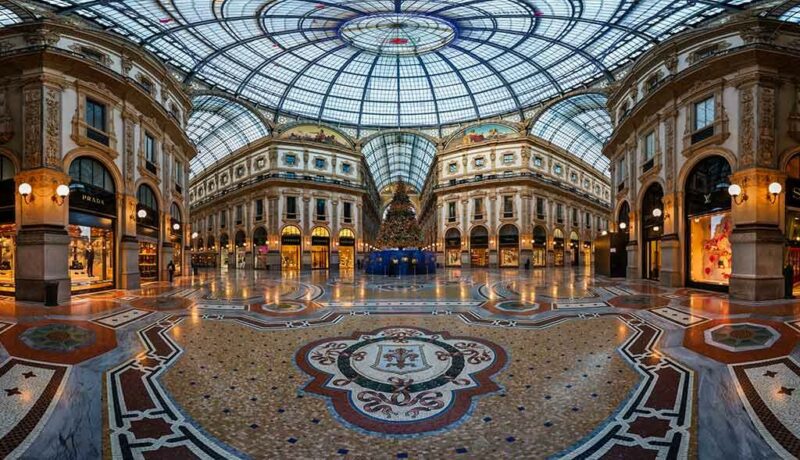The Galleria Vittorio Emanuele II in Milan was inaugurated on September 15, 1867. For 157 years, it has symbolized elegance and sophistication , earning its place as a must-see landmark during a luxurious stay in Milan. Here are 10 intriguing facts about one of Milan and Italy’s architectural icons to mark this anniversary.
The name and initial plans The Milan’s Galleria Vittorio Emanuele II was named in honor of Victor Emmanuel II, the King of Italian Unification (1861) , who was also commemorated with the Vittoriano (or Altare della Patria ) in Rome. Naming the new gallery after him was a gesture of respect but also a strategic move by the municipal council to gain more support. The primary purpose of the Galleria was to ease city traffic and create a better connection between Piazza Duomo and Piazza della Scala.

Finding the perfect design took three years, from 1860 to 1863. The first competition attracted an overwhelming 176 submissions, necessitating a drastic reduction. (On the right, is the start of the construction).
The architect never saw the Galleria completed The design by architect Giuseppe Mengoni won the competition and was selected, albeit with some modifications, to begin construction. The foundation stone was laid on March 7, 1865, by King Vittorio Emanuele II. Tragically, Mengoni never saw the completed Galleria.
In 1877, ten years after its inauguration, Mengoni fell from scaffolding during the final touches. His death remains shrouded in mystery, with some speculating about suicide . Three major restorations Originally, the Galleria was not constructed as we know it today.
The first major restoration was needed after the bombings of August 1943 during WWII , which continued until 1955. Also, the image shows one of the façades destroyed after the bombings. For the centennial of the inauguration, the floor, and mosaics were refurbished, completing some unfinished work from the initial restoration.
The most extensive and revolutionary restoration occurred for Expo 2015, involving 35,000 hours of work . This restoration restored the original colors of the plaster and materials , bringing the structure closer to its original vision. The Galleria in literature The Milan’s Galleria Vittorio Emanuele II quickly became a hub of Milanese high society and intellectuals .
It appears in the works of contemporary writers such as Giovanni Verga , Thomas Hardy , and Mark Twain . “I walked at a leisurely pace along the Via Alessandro Manzoni till my eye was caught by the grand Galleria Vittorio Emanuele, and I entered under the high glass arcades till I reached the central octagon, where I sat down on one of a group of chairs placed there.” – Thomas Hardy, A Changed Man “Il povero diavolo avea gran bisogno di scarpe e di quattrini; le sue scarpe s’erano logorate a correr dietro le larve dei suoi sogni d’artista, e della sua ambizione giovanile, – quelle larve funeste che da tutti gli angoli d’Italia vengono in folla ad impallidire e sfumare sotto i cristalli lucenti della Galleria.
” – Giovanni Verga, Primavera e altri racconti The bull legend and luck ritual When it comes to Italian traditions and superstitions, the Galleria is no exception. One of its most famous rituals involves a mosaic of a bull. According to tradition, spinning three times with the right heel placed on the bull’s genitalia will bring good fortune .
This quirky custom, popular with tourists, was originally a jest directed at the city of Turin, whose emblem features a bull. The Nickname “Milan’s Living Room” From its inception, the Galleria attracted numerous visitors and quickly became a social hotspot. It was soon nicknamed Milan’s Living Room (Il salotto di Milano in Italian) , thanks to its elegant shops and cafes frequented by the city’s elite .
A VITTORIO EMANUELE II. I MILANESI The main arch of the Galleria features the inscription “A VITTORIO EMANUELE II. I MILANESI,” which translates to “To Victor Emmanuel II.
From the Milanese.” Store signs in black and gold To maintain an air of prestige and luxury, stores in the Galleria must adhere to strict municipal regulations: signs must be in gold on a black background . This rule has even applied to well-known fast-food chains like McDonald’s, despite the color scheme not aligning with their brand.
As of 2012, McDonald’s is no longer located within the Galleria. Initially gas-lit In the late 19th century, gas lighting was still common, and the Galleria was illuminated by gas lamps until 1883. Lighting the entire space became almost a ritual , involving a small locomotive that gradually lit all the lamps.
From 1883 , the Galleria switched to electric lighting , marking it as a center of technological innovation. Inspiration for Naples’ Galleria Umberto I The innovative architectural design of the Galleria inspired the creation of another famous Italian gallery. The Galleria Umberto I in Naples (1890) reflects Milan’s gallery’s dome, arches, and layout, serving as a tribute to Victor Emmanuel II’s son, Umberto I.
Related Posts:.



















